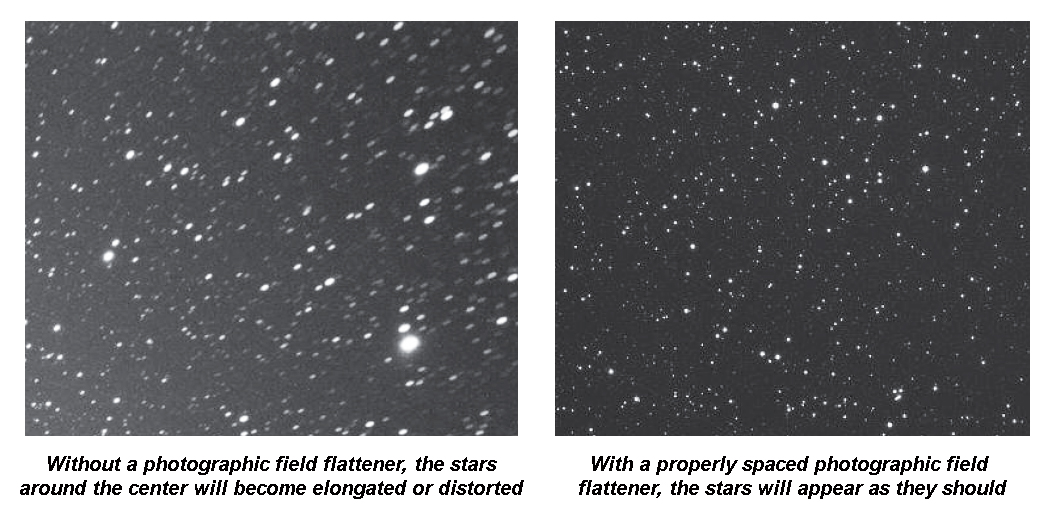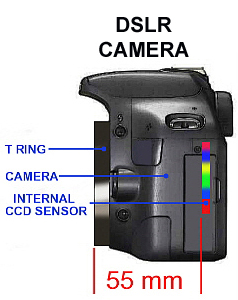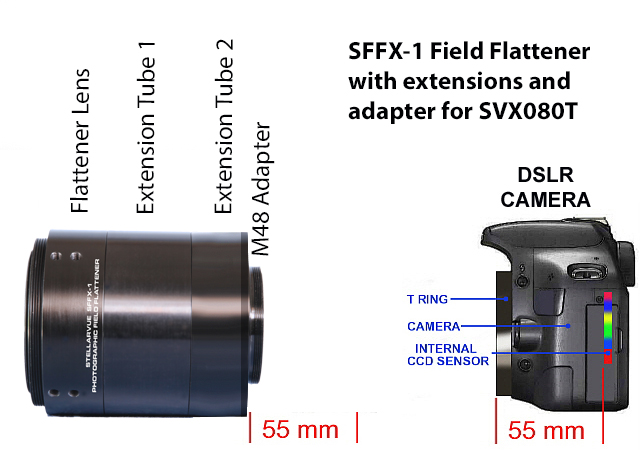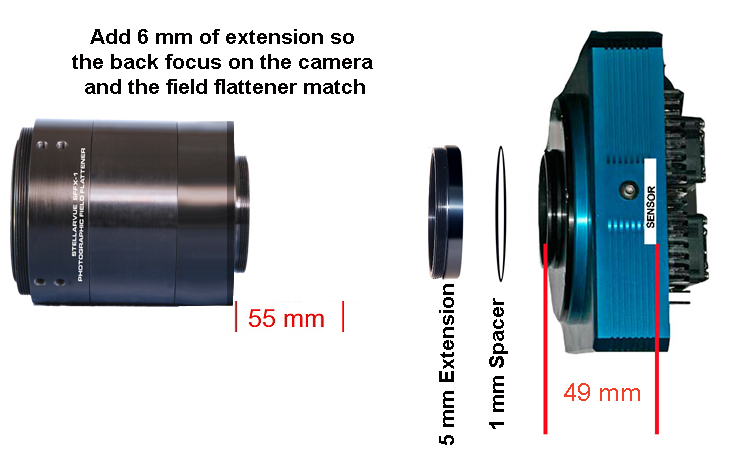Using Field Flatteners
Using Photographic Field Flatteners (and Reducer/Flatteners)
Refractor telescopes are made to be used visually with an eyepiece. To use a telescope for photography an optical device is needed to convert your telescope from a visual instrument to a photographic camera lens. This optical device is a field flattener (or reducer/flattener). Without a field flattener stars that are not in the center will appear distorted.


Spacing is critical. What does this mean? For the photographic field flattener to work properly it must be a precise distance from the camera sensor. If it is too far away from the sensor or too close, the stars around the edge will be distorted. So to make sure the field flattener is spaced correctly from the camera you need to know the distance from the camera's attachment thread to its sensor. This distance, measured in millimeters is known as the "camera back focus."
Again, camera back focus has nothing to do with focusing. It is the distance in millimeters from the front of the camera to the sensor in the camera. The back focus distance for a Canon or Nikon camera with the lens removed and a t-ring attached in its place is 55 mm. We refer to this as the "standard DSLR spacing."
This standard DSLR spacing is the same for some but not all ccd or cmos cameras. For example, ZWO cameras come with extension tubes that provide a back focus of 55 mm. This makes it easy to swap out ZWO cameras with DSLR cameras.
Unfortunately, many ccd and cmos camera manufacturers do not conform with the standard DSLR spacing of 55 mm. So you need to know your camera's total back focus (again, distance from the thread to sensor) to make sure the field flattener is the proper distance from the sensor. Now don't start sticking a ruler down your camera opening! Check with the camera manufacturer. They should have the actual back focus spacing listed in the manual or on their website.
Stellarvue field flatteners and reducer/flatteners come with extension tubes and spacer rings. These are added to the flatteners to reach the standard DSLR spacing of 55 mm. So when you purchase our field flattener for a given telescope it will come with the spacers and/or extensions needed for it to work with a DSLR, ZWO and many other cameras. In the picture below we show the SFFX-1 Universal Field Flattener designed for the Stellarvue SVX080T refractor:

As you can see this flattener assembly is supplied with two extension tubes and an adapter. When these extension tubes are threaded on as shown, the flattener assembly will give its best performance with an 80 mm f-6 telescope and a camera with a 55 mm back focus. Since DSLR cameras with a t-ring have a 55 mm back focus, this flattener with the extensions in place is matched to the camera. You thread the flattener's M48 thread into the camera's t-ring and you are good to go!
What if I get another camera with less back focus? Now if you buy a camera with a different back focus you can still use the field flattener but you will need to adjust the spacing. Let's say you have a DSLR working perfectly but now you purchase a one-shot color ccd or cmos camera that only has a 49 mm back focus. Here is what you do:

Obviously, to get the sensor spaced properly fom the field flattener you need to add 6 mm of spacing. You do this using extension tubes and spacer rings available from Stellarvue. Since you need to add 6 mm, you will use a 5 mm extension tube and a 1 mm spacer ring. Remember, the extension tubes and spacer rings need to be the same thread size as the field flattener and camera (in this case they are M48).
What if I get another camera with more back focus?If the camera has a much longer back focus, say 65 mm, you will need to remove one or more of the extensions that came with the field flattener assembly and replace them with shorter extensions. In this case you will need to shorten the extensions by 10 mm so the field flattener assembly has a back focus of 65 mm, matching the camera.
We make our field flatteners with a long back focus so they will work with a variety of cameras. This way, if you buy a new camera with a different back focus, you can merely obtain the proper extension tubes and spacer rings required for your camera.
The Set Up: Now that you have determined the back focus of the flattener assembly (field flattener with extensions and adapter) and the camera are the same back focus it is time to attach everything. We will use a DSLR with t-ring as our example.

You are now ready to simply focus and shoot.
